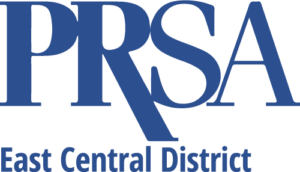QUICKSTART LEADERSHIP CONFERENCE 2021: VIRTUAL AGAIN, VITAL AS EVER
QuickStart Leadership Conference 9-17-2021
In what we have come to know as the “new normal” the 2021 QuickStart Leadership Conference was yet again a virtual format. The ECD board looked at the bright side: a compact session for attendees, a virtual jet-setting crowd of speakers (hello, London calling!), pennies-on-the-dollar cost comparison, and above all, continuity. Pandemic be damned, the show carries on!
ECD chair John Palmer opened the conference with a review of ECD board accomplishments. “DEI initiative kicked off this year and the board has been very active on the topic,” said John. “We’re working on a program for DEI chairs in October. No journey is too long with the right company. It’s always a great collaboration to have working with PR pros.
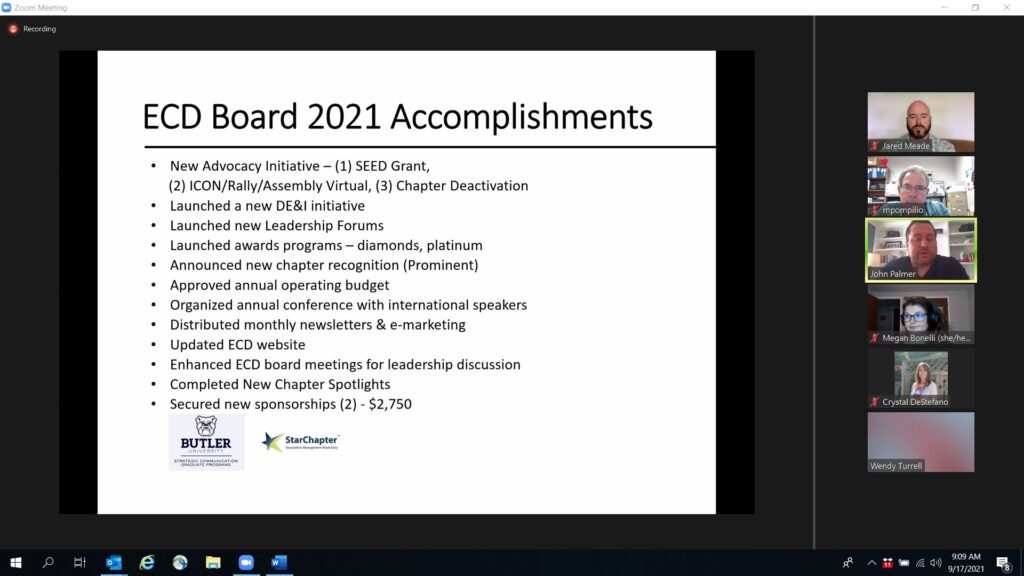
But First a Word from Our Sponsor… Butler University Master’s in Communications Program
Mark Rademacher from ECD sponsor Butler University took the floor to talk about the master’s in communication program. “It’s 100% online and built for working pros,” he said. He outlined a program of intensive courses; optional weekly zoom meetings; the 10-course program can be completed in 20 months. There are 5 required foundational courses; 5 elected courses to tailor experience for goals. Admission counseling focuses on good fit; it’s a small program with no more than 25 students in a cohort.
Membership Recruitment and Retention with PRSA membership chair Bart Graham:
“Crickets” said Bart was the response to his call for volunteer outreach from PRSA. “How do we retain the members we have?” he asked.
He called membership a four-legged table: recruitment/retention/volunteering/engagement. “Think about it this week – you’re going along as a chapter, you’re recruiting like crazy, but you have to engage them and have to keep them.”
Bart’s WETP approach: Welcome new members and guests; Engage with all, be Prompt with your welcome, Thank members and guests.
What has worked: Reaching out by LinkedIn and network; spotting new members weekly on the national directory and reaching out; not being shy about “volun-tolding” someone! Use LinkedIn messaging. Quarterly contacts with chapter or section members; starting small member meetups with COVID guidelines; zoom chats apart from regular programming is popular. Work closely with chapter presidents. Bart says, “It helps to have a screw loose!”
“Anything to get members out to a meeting or chapter chatting with each other,” said Bart. “Single stay-at-home mom for example, is struggling on how to do this. I’m always thinking of new and different things to do. As long as it’s legal, they pretty much let me do it! They know me and usually run the other way because they know I’m going to ask them to volunteer for something!”
Emotional Intelligence: 5 Leadership Skills Communication Pros Must Know with coach Heather Evans:
Heather said there are five pivots, five choices you can make to set into the strongest leadership position, your strongest self. Each one is about communication. Emotional intelligence and deep leadership begin inside ourselves and with communication. There is a sea change in leadership today, and how to step into leadership.
Anchors to leadership are about ways to communicating, about “languaging.” Language carries with it intent and creates change.
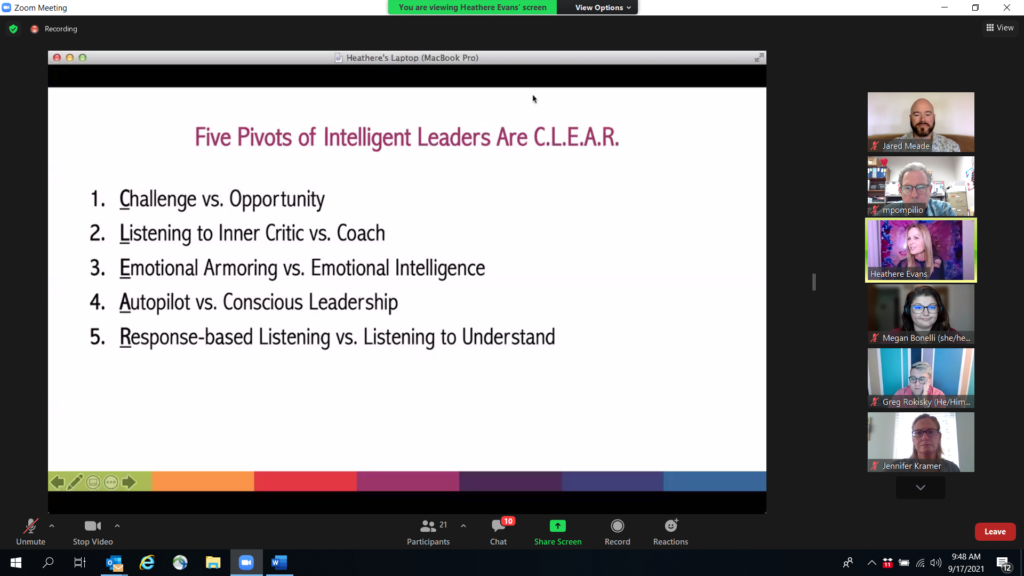
5 Pivots are CLEAR:
Challenge vs. Opportunity
Listening to Inner Critic vs. Coach
Emotional armoring vs. emotional intelligence
Autopilot vs. Conscious leadership
Response-based listening vs. listening to understand
- Challenge vs. Opportunity: the neurobiology of leadership.
Stress, anxiety, irritably (amygdala) blocks the neocortex creative center of the brain from rational thinking. If we are going to step into strength of leaders, we must claim ownership over our own minds.
More dominion over our minds need resilience, trust/safety/innovation. Gateway is self-awareness, self-regulation, motivation, empathy and social skills.
Small tweaks have big impact (Japan’s Kaison way).
We don’t have to feel overwhelmed. A small tweak is what these pivots are. So you are not cutting off access to your most resilient self.
2. Listening to Inner Critic vs. Coach: Exercise: take 3 or 4 deep breaths/hold/exhale.
Leaders have mastery over the inner conversation.
Notice pattern of negative thinking and shift the other way.
Between stimulus and response is a gap. That’s where real leadership lies: our response to everything around us.
The voice is yours. I’m in charge, it doesn’t get to run me. Who am I listening to? Is it my inner critic? The inner coach has a different voice.
Recognize inner strengths. IC is trying to protect us from doing something wrong, looking foolish, feeling shame. When in balance, notice we don’t want IC to go away, but keep in balance (out of balance, it is a perfectionist, highly critical; rule maker, opinionated observer).
What is one good thing that could happen if I was less critical?
Asking yourself questions that require you to think puts you into your highest brain capability.
3. Emotional armoring vs. emotional intelligence: signs – anger, being right, trying to control – protective mechanism too. Result is lot of toxicity.
Toxin – behavior – antidote
Toxin: blaming, defensiveness, stone-walling, contempt
Behavior: attack, victim, withdrawal, hostility
Antidote: soft start, open mindset, curiosity
Personal responsibility, curiosity 2% truth
Courage, speak up, transparency, coaching
Highly damaging to giver and receiver, personal development
Coming in with curiosity triggers neocortex. Ticket out of defensive position is personal responsibility. Get more curious about that.
2% truth – feedback may be negative, feel defensive, but what if there was just 2% truth to it – what could I take out of that?
Courage to speak up, may help to have coaching.
What situations bring out this toxin in you? in your team?
The antidote to armoring is curiosity.
4. Autopilot vs. Conscious leadership
Conversation starters: the story I made up… I’m curious… tell me more… I’m wondering… help me understand. Walk me through that… WHAT IS YOUR PASSION AROUND THIS? Tell me more about this… tell me why this doesn’t work or doesn’t fit for you…
Words change your brain
Disempower language vs. owner language
I should, I ought to, I have to… swamped, stress… get through… (now running on less capacity)
Shift to owner: intend to… I choose to… I want to… (uses what I’m going to get from this, what is the gift in the garbage? How can I use this? How can this situation strengthen me? Owner language changes our brain.
5. Response based listening vs. listening to understand
No. 1 complaint about relationships – not listening.
Part of not listening is you already think you know. Our perception is accurate and complete. There is a different scenario to everything, but we believe our perception is complete and that impacts our ability to listen.
3 levels of listening
Level 1 – internal – Attention is on your thoughts, feelings and interpretations.
Level 2 – focused – periodically checking accuracy of your understanding.
Level 3 – global – encompasses the environment, your senses.
Perception Checking: I hear you say… is that accurate? If I’m hearing you accurately you mean… How does what I’m saying fit for you?
Mind reading: I heard you say… which means… it seems you are saying this that means that.
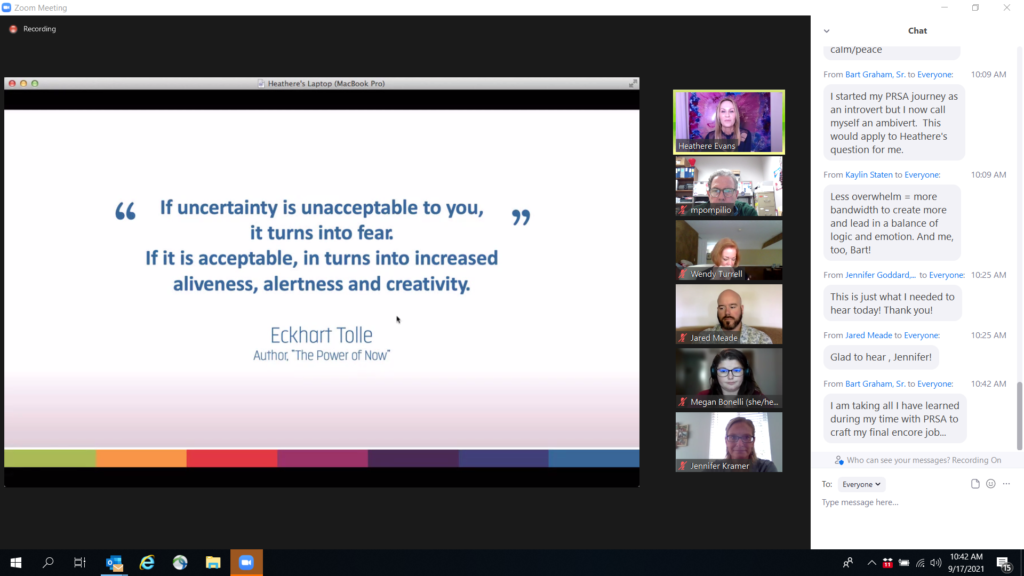
Unconditional Positive Regard (assuming positive intent)
Neutrality – key if on the receiving end of feedback – recognize all feedback is just information. Ask clarifying questions, etc. is strength of leadership.
Leadership is a mindset.
4-part process: objection – contraction – exploration – buy-in:
Objection: “this cannot be good” is stress response.
Contraction: “I don’t really want to deal with this.”
Exploration: “How can I make this work for me?”
Buy-in: “I have figures out how I can make this work for me, and for others (team).”
Game-changing transformation leadership.
Coaching exercise: think of challenge, explore choices making no commitments, prize yourself for being willing to go for the learning.
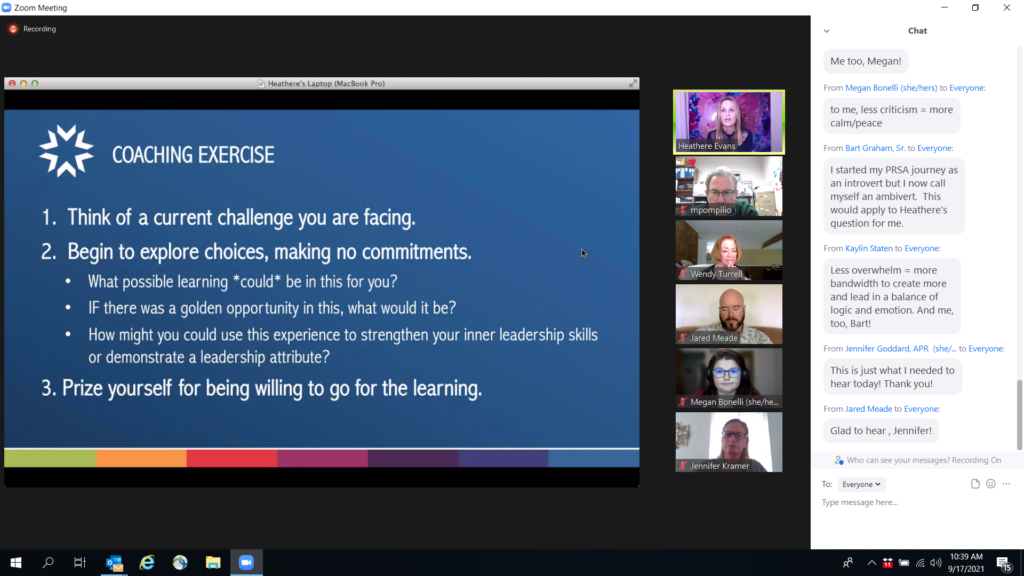
And now a word from our sponsor: StarChapter Update by Rebecca Chadwick:
The challenges to volunteer leaders this past year has been great. They value StarChapter for much more virtual engagement and its convenience. StarChapter helps increase membership, revenue, attendance, value, insights; decrease learning curve, effort, time, redundancy.
The Difference between Authentic DE&I Recruitment and “Pandering” with Barbara Phillips:
Authentic recruitment has broadened out to the culture, said Barbara in her presentation from London.
Privilege: We all have privilege. “When you are accustomed to privilege, discussion of DEI can feel like oppression.” No one needs to be shamed, feel uncomfortable; but like any transformation program, it may feel uncomfortable.
Barbar said the UK has 9 protective characteristics enshrined in law. There is only one group that is actually pandered to, by definition of the word pander, and that is the white male, heterosexual with the most advantage in workplace.
Clean up before inviting folks over.
See what’s there now in your organization and clean it up. Global mindset – not just geographic, but universality. Global mindset indicated by qualities – openness; awareness of your culture’s impact on other cultures, especially if yours is the dominant culture; global understanding; treat others as they want to be treated.
Look at the bricks of your organization and acknowledge you would like to be diverse but may not be. You cannot do anything about recruitment until you understand what is going on inside the organization and the corporate structure. DEI strategy must be imbedded in corporate strategy (it’s not just about tactics). Draw a line under it and start again. Re-imagine it. Accountability, and share success.
Questions to ask yourself or clients if you want to be diverse:
- Why is our leadership in the pipeline so white and so male?
There is no talent pipeline problem. Why do we think there is a pipeline issue?
- What is your organization doing about pay gap? If same job pays more for another individual, why is that?
- Why are there practices that allow discrimination, and why are we not holding anyone accountable?
- Why isn’t there more lived experience in those in organization speaking for DEI?
GOALS:
- How hard would it be to actually find meaningful board representation?
- How hard is it to find visible representation among senior leadership?
- How hard is it to establish a safe environment for all employees?
- Performance procedures, evaluations that disadvantage groups – what are you doing to dismantle that?
- How hard would it be to commit and finance long-term culture change and transformation? (where all employees can succeed uninhibited).
Social media has opened up messaging about what is happening inside the organization. One continuum of message: make sure it is consistent. No one is immune from this. Lived experience representation is changing.
Pay gap is one process.
Creating meaningful support groups are only worth having if members of the group are allowed to be part of the decision making that affects them. Include them.
Visual representation – look at the black and brown bricks at bottom of your triangle and figure out why they are not higher up. You cannot conduct any meaningful DEI strategy unless you consider this.
Meaningful board representation. Recruit from within; don’t assume someone is comfortable remaining in one position. Speak to people in the community – they will tell you who to recruit. If you want talent to be diverse, make room for them, expand for them. Don’t box everyone in for low level job, etc. Sometimes skip levels. Go down, some people haven’t been given the opportunity. Something may be oppressing opportunity within the organization.
Psychologically safe environment means you can be authentic, no fear of being authentic, can take risks, path ethically is clearly defined.
Grievance procedures awarded behaviors – check how they compare, check that with the cultures.
Micro-aggression – everyone knows it exists. If someone comes to you, believe them. They have thought long and hard about coming to you.
Authentic recruitment- demand more from your recruiters. Demand more if list is not good enough. It is up to the client to demand more; access different networks; partner with them not patronize. Go public with your intent and ask for support. We need you to support us.
Make sure DEI is represented in your mission, values, operating procedures.
See diversity of candidates and use that knowledge in your solution. Don’t underestimate the grapevine – what is being said about your organization. Employees will absolutely talk to new recruits.
You have to look at your organization first and go out there and make sure you understand the culture.
If serious look at PIP.
Feedback Time in the President’s Forum:
Chair-elect Jared Mead said the 360 Survey revealed membership recruitment/retention as central concern of all chapters.
What is the impact of the cost of membership?
Bart said money factors it into it. “I hear people saying my company isn’t paying for it anymore. Chapters are doing something different for hardship. Some people simply forget. Reach out to members. It is COVID and we hope it comes back but can’t guarantee it.”
Megan Bonelli said members ask, “Will we meet in-person again?” It’s hard to be on camera all day. The level of communication can be a lot. Multiple emails per week. Videos can take time. Member organizations were in decline ahead of COVID. Small groups, committees? We’re out of fresh ideas right now.
Bart’s final word of advice: Keep track of members and engage.
